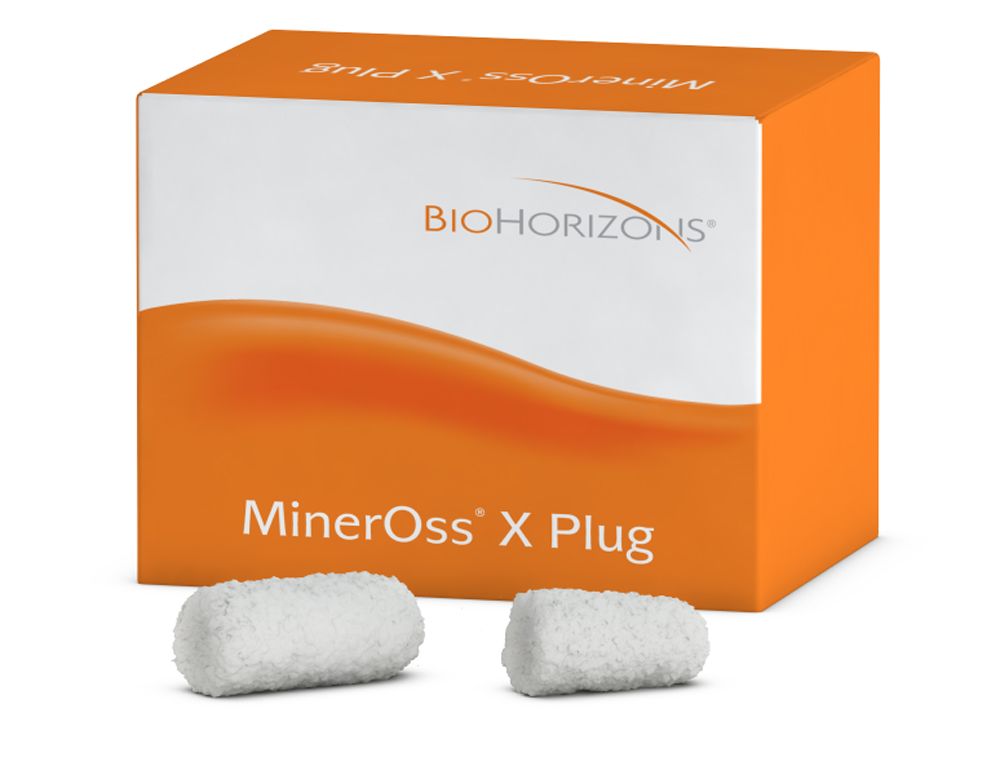Preservation of the ridge is the go-to philosophy in dental extractions today. Extractions done for preimplant placement and preservations for fixed and/or removable prosthodontics are indications for modern-day socket grafting. Because this procedure is so popular, manufacturers continue to modify grafting materials. Let’s examine BioHorizon’s latest addition to their portfolio of grafting offerings, MinerOss® X Plug.
Traditionally, socket grafting involved mixing a saline solution with specific particulate to create a slurry of material that was then placed into the socket and followed by placement of collagen barrier and final suturing. Now fast forward to MinerOss® X Plug, a cylindrical plug that comes in 2 shapes, straight or tapered. The plugs are easily trimmed and inserted directly into the socket without the need for rehydration. Yes, gone is the mixing of particulate into a slurry, gone is suctioning the loose particles from the area, and gone is the collagen barrier.
The plugs are 80% bovine cancellous particulate and 20% bovine type 1 collagen. The collagen material allows for rapid blood absorption and delivery of the particulate. The bovine cancellous matrix supports new bone growth in the socket area. Costs per plug are lower than the total costs of particulate, collagen barrier, and saline solution. Inventory is far simpler than ordering the multitude of products for previous socket grafting. The plugs come in only 2 shapes and sizes (tapered, 9 × 15 mm; straight, 10 × 20 mm) and that is primarily all you need for your socket grafting procedures.
MinerOss® X Plugs
MinerOss X Plugs are designed to simplify and streamline the grafting process with 2 size options shaped for a variety of graft sites. The plugs are composed of 80% bovine cancellous particulate and 20% bovine type I collagen. They offer optimal clinical handling, are easily trimmed and shaped to fit the morphology of a socket defect, and do not require rehydration before implantation. MinerOss X Plugs also feature dependable delivery. Particulate embedded in the collagen may prevent particulate migration and the collagen allows for blood absorption and delivery to the particulate.
BioHorizons
888-246-8338
biohorizons.com
The Evaluation
This product was evaluated by Catapult Education. Here are the evaluators’ findings:
- The evaluators utilized both shapes and their final choice was split among the group, but all felt these 2 sizes were adequate.
- One-third of the group hydrated the plugs prior to placement (instructions say not required). The ones who did found the material very easy to hydrate.
- One-third of the group used membranes in conjunction with placement of this product.
- All of the evaluators loved the handling.
- All of the evaluators said they would buy and use this material for socket grafting.
- The majority of the evaluators said they would use this product with other procedures that include filling of infra-bony periodontal defects, filling of defects after an apicoectomy, root resection, peri-implant defects, and elevation of maxillary floor.
Clinical Example
Now let’s take a look at a specific case and see how unique this product is.
A 72-year-old patient presented with chewing sensitivity on her upper first molar. Upon examination, there was a parulis (on the buccal) above the mesial root, no mobility, tenderness to percussion, and probing showed a small exudate on the mesial buccal root. One periapical (Figures 1-2) was taken followed by cone-beam computed tomography that showed a large periapical lesion proximate to the sinus with the bone loss extending up into the furcation, which was potentially indicative of a fractured root. The decision was to extract the tooth and graft the area and then do an implant treatment later in the year.
After the patient received an injection of 1.5 carpules of Septocaine 4% 1:100,000, the procedure began with retraction of the soft tissue and the beginning of minor elevation. During this initial elevation, the crown immediately dislodged and exposed the previously placed post and core (Figure 3).
With further elevation, the post was dislodged and all 3 of the roots and the vertical fracture of the mesial root were clearly evident. The remaining roots were sectioned using an NSK surgical electric handpiece, and each subsequently was removed via routine elevating techniques (Figures 4-7).
Careful apical debridement and irrigation was completed. A tapered 9 × 15 mm MinerOss® X Plug then was removed from its packaging (Figure 8).
The plug was cut into 3 pieces (Figure 9) with the majority of the grafting material placed (nonhydrated) into the palatal and distal sockets (Figure 10). The technique involved only mild condensing into the socket.
Final suturing was a figure-8 technique with a standard 4-0 gut suture (Figure 11).
As seen in Figure 11, the area is free from the usual free-floating particles. An additional advantage to this material was not having the risk of slurry of particles so close to the sinus. Healing 1 week later looked well within the norm. At the 4 weeks postoperative appointment, the area was well healed with primary closure.
Conclusion
We are always looking at the more cost-efficient techniques and products that ultimately create an equal to or more superior outcome. Over the past 12 months and many socket grafting procedures with this product, we continue to see excellent postoperative results and view this product as a significant shift in our clinical socket grafting protocols. Catapult Education gives MinerOss® X Plug the Catapult Vote of Confidence.


